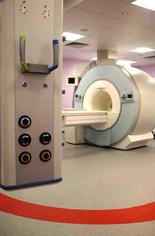MRC Centre-BRC MRI Biomarker Collaboration in Lancet Neurology:
Important implications for experimental trials in Neuromuscular Diseases
A UCL Institute of Neurology study published in Lancet Neurology this week provides important prospective evidence that quantitative MRI can reliably and sensitively track disease progression in Neuromuscular Diseases. The research shows that the MRI biomarkers developed by the MRC Centre team have real potential to become the widely adopted surrogate endpoint in neuromuscular trials.
There are over 100,000 people in the UK with progressive muscle wasting Neuromuscular Diseases. They include motor neuron diseases, muscular dystrophies, neuropathies, degenerative myopathies, mitochondrial diseases and channelopathies. They span the age range from children to adults and either cause premature death or lifelong disability. Neuromuscular diseases account for ~20% of patients assessed at paediatric and adult UK neuroscience centres. In recent years there has been remarkable progress in gene discovery and most disease causing genes have now been identified. Post-genomic pathophysiological understanding of disease mechanisms has reached an advanced stage with huge potential for new therapies.
In the UCL MRC Centre for Translational Research in Children and Adults with Neuromuscular Disease over 40 disease causing genes have been identified, stratified cohorts exceeding 10,000 patients have been built, a biobank of over 3000 patient muscle lines supports preclinical science and a UK experimental trials platform has enabled natural history and experimental trials. Based on preclinical molecular understanding a range of new therapies have been developed for experimental trials.
A major obstacle to experimental trials of new therapies is the absence of a reliable, sensitive and valid biomarker that tracks disease progression and correlates with patient function. MRC and BRC funded work over the last 7 years has enabled the development of quantitative MRI biomarkers.
An initial scientific observation was that a wide range of different primary molecular defects causing neuromuscular diseases are linked to a final common pathway of muscle damage. This “damage pathway” is characterised by abnormal intramuscular water accumulation followed by a process of probable muscle cell and fibroblast de-differentiation into adipocytes and intramuscular fat accumulation.
Work by MRC Fellow Dr Jasper Morrow, MRC Centre physicist Dr Chris Sinclair, and BRC-supported Dr John Thornton, enabled them to develop and apply MRI methods to reliably quantify intramuscular water and fat.
The data published in Lancet Neurology represent the first results from applying these quantitative MRI sequences prospectively in two stratified cohorts of neuromuscular patients (Inclusion Body Myositis and Charcot Marie Tooth Neuropathy which are amongst the commonest examples of a myopathy and neuropathy) over a 12 month period. Patients underwent in-depth phenotypic characterisation and had synchronous detailed evaluations assessing many aspects of motor function and strength, including validated patient reported outcome measures.
These findings convincingly show that the MRC Centre MRI protocol biomarkers were more sensitive and reliable than other biomarkers developed in these diseases to date. The correlations with patient function were highly significant.
I am delighted that the work of the radiology and neurophysics teams has enabled the development and application of these MRC MRI protocol sequences. The results were striking. It was clearly shown that these MRI biomarkers measures are sensitive, reliable and valid.
These results represent a significant step forward in biomarker development for progressive neuropathies such as disabling Charcot Marie Tooth Disease. The data clearly show that these MRI biomarkers are the most sensitive that have been developed to date. We are now leading international multicentre studies using the MRC Centre MRI protocol
Professor Mary Reilly, Co-Director, MRC Centre for Neuromuscular Diseases
International academic collaborators and industry partners are now adopting these MRI biomarkers and work led from the MRC Centre is ongoing to standardise across centres. It is likely that these biomarkers will be relevant across most, if not all, muscle wasting neuromuscular diseases and will be a valuable tool in the assessment of experimental molecular therapies.
An accompanying commentary in the Lancet Neurology concluded “Overall, this study clearly shows the value of MRI to monitor disease progression and sets the stage for its use in clinical trials for Charcot-Marie-Tooth disease 1A and inclusion body myositis. With increased evidence of the validity and sensitivity of magnetic resonance biomarkers in neuromuscular diseases, the path for biomarker qualification (eg, their approval by the Food and Drug Administration) should be carefully explored, with the ultimate goal of using magnetic resonance measures as surrogate endpoints in clinical trials.”
I am very proud that this work was a truly multidisciplinary team effort over the last 7 years in the MRC Centre. It included pathologists, geneticists, neurologists, physicists, radiographers, research nurses and physiotherapists and radiologists. Patients and patient charities including the Myositis Support Group and CMTUK were also critical. This progress is an important foundation for future MRC-BRC experimental trials in the next phase of the UCLH-BRC. It advances the likelihood that MRI biomarkers will indeed be used as the preferred surrogate end points in neuromuscular clinical trials. This work would not have been possible without critical support to the MRC Centre from the UCLH Biomedical Research Centre.
Professor Michael Hanna, Director of the MRC Centre for Neuromuscular Diseases
Thanks to all our members who have raised funds for Research, enabling us to fund this study for three further years. If you would like us to continue funding vital work of this type, please do make a donation by clicking the “Donations Accepted” button on this page.





